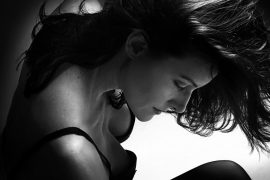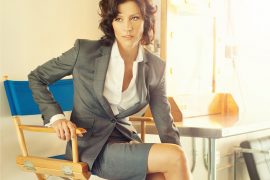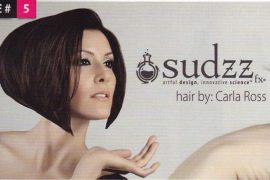Most of what you might already know about Jean-Claude Vorgeack either has to do with his voice or what’s engaging his eye. He was a radio DJ for seven years with L.A.’s KXLU before he transitioned into fashion photography and left the airwaves behind. YBR checked in with the Los Angeles native and now full-time photog after he shot the latest SUDZZfx® Urban Icons hair campaign at Carla Ross’s More Than a Slash Academy. We talked hair, of course, but also lighting, music, and even Helmut Newton.
Jennifer Massoni Pardini: How long have you been a professional photographer?
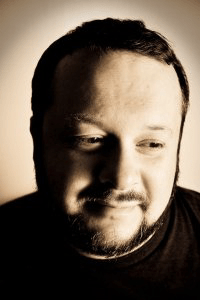
Jean-Claude Vorgeack: It’s hard to put my finger on that. When I first started dating my girlfriend, who is now my wife, I was actually a musician. I played in bands, I used to DJ clubs, I used to do a radio show, I used to produce. It was music, music, music. She had the photo background. We would go on dates that consisted of walking around with a black and white film camera. This was before digital. It was a little old manual. No meter. No auto anything. When every click costs you money, it encourages you to get better fast.
I bought my first digital camera and starting getting into lighting and what have you. Not to be corny, but it just clicked. It’s the same with photography as with music… I value the creative over the technical. I like working with people who didn’t necessarily go to school, but are passionate about what they want to do and they bring that to their craft.
JMP: Did you want to go into fashion photography in particular?
JCV: I’ve always loved fashion, ever since I was a kid. Early on I got the connection—maybe because my mother tried to dress me—that when I wore things that I picked, I felt better. Having a sense of style and having personal aesthetic can make a person feel good.
To me, fashion is about style. When you wear things that make you feel a certain way—confident, attractive, comfortable—it’s a reflection of self. And I love working with it in photography. It tells a story. When you have the right set, the right wardrobe, instantly you have a story in a frame.
JMP: I imagine it isn’t an easy segment of the industry to break into?
JCV: (Laughs.) One percent really gets to do the big campaigns and the big editorials. That can be scary when you look at it from the outside. But the more I’m in this, and I’ve been doing fashion photography for about five years, the more I realize there’s so much work. It really is an abundant universe. It’s easy to get hung up about who is getting the big campaigns, etc., but I abandoned that way of thinking a while back. I’m grateful for every job that comes in and apply myself best I can and just enjoy it. By continuing to do that, the jobs get better and better.
![]()
JMP: Tell me about the shoot location and the resources you had available for the SUDZZfx® project.
JCV: The SUDZZfx® team wanted to shoot the campaign at Carla’s hair salon/academy instead of at my studio. Carla is an amazing person, one of the most amazing people I’ve worked with, not only in terms of talent, but also her warmth. She has a really good soul. I said, ‘I’ll compromise, we’ll do it there.’
It was challenging because they have very low ceilings. Photographically, it was not ideal, but I wanted to make it work for her. She assembled a crew of people for the shoot who made me feel welcome. I couldn’t have asked for a better group of people to spend that weekend with.
Resources were being thrown together up until the night before the shoot when two wardrobe stylists, Michelle Hernandez and Lisa Ann Karst, contacted me with jewelry they had available to shoot through the weekend… I told them that if they didn’t mind jumping on a moving train, to see what they could do for us. They brought the most amazing jewelry you have ever seen.
They were a gift, plain and simple.
![]()
JMP: In terms of getting ‘the shot,’ what is your vision?
JCV: Everything culminates in the shot. Everybody’s pieces come together and then I do my thing. When a shot comes out great, and I get something that is magic, the truth is I can’t do it alone and the fact is I wouldn’t want to. It takes what everybody does to really get something special.
If you work with people who are good at what they do and trust them to do their job, chances are you’ll get something you’re happy with. And Carla gave me the freedom to get creative.
JMP: Speaking of creative vision, I’d love to have you describe your concepts for the two campaign shots of Jacqueline Depaul:
JCV: For the profile headshot, I had been studying Jacqueline’s face in makeup. I’m big on faces. She has this great, beautiful jaw line. I decided to shoot her in profile, both to capture Jacqueline’s bone structure and Carla’s hairstyle, which was cool in front and back, really ornate work. I wanted to find an artful way to document all sides of it.

I lit Jacqueline from in front and in back to make it more dramatic. I don’t know if it was the tutu, but she just started to dance. She moved so nicely with really graceful hands and arms and that long elegant neck. She’s one of those pleasures. She gives you the frame you’re looking for very quickly. She’ll ask for a little direction, but she has good instincts.
When I work with good models, what they all have in common are instincts. No matter what you put them in—a Victorian ball gown, a leather jacket, nothing—or where you put them—a barn, a château, a back alley—they look like they belong there. That is the difference between a good model and a great model.
The second shot, the full length Helmut Newton inspired shot, was literally the last shot we did on the last day. It’s less of a hair shot. It was magic… when everybody is doing their thing and you have an amazing model, you know the second you hear the camera click—that’s it.

We put Jacqueline in wardrobe to change her for that look. I saw her and she was a knockout, just a knockout. I went down to buckle a strap on her shoe and I could tell she was like a caged tiger pacing back and forth, saying, ‘Let me out! Let me out!’ After being in hair and makeup for so long, she just wanted to go. I said, ‘Come on, we’ve got to take this picture!’ Within three or four frames, it was happening.
When you’re already getting good stuff right there, that means we’ve done everything right: lighting, wardrobe, hair. You can just get greedy and fine tune. It becomes this cool dance between the model and photographer. That’s what gets me out of bed in the morning.
JMP: How did this last shot in particular evoke Helmut Newton?
JCV: Helmut Newton loved big women of heroic proportions. Because when they photograph, they give you these lines. Your eye as the viewer, it’s a playground. I think he would have loved Jacqueline: 5’11, all leg. More than that, it’s that fire Helmut liked.
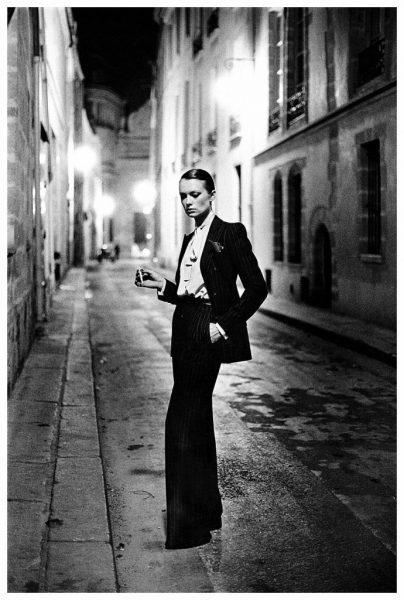
We put Jacqueline in the corner with one of the mirrors of the salon, so you got the doubling of the shadow behind her and all that leg duplicated in the mirror. When I was lining up the shot, I knew it had to be black and white. If color doesn’t help tell the story, then dispense with it. Let the viewer sort out what’s warm, cold. Let them see light, shadow, form, structure. This wasn’t about color. This was about these amazing lines converging at the top and, ultimately, it was about that expression. If you get to the face, and the face doesn’t have conviction, it throws the whole thing out. The face is the punctuation. If it completely sells it, I’m going home happy.
JMP: Can you explain how you approach working with a model, using Jacqueline as an example?
JCV: I have a policy. I won’t shoot editorial with somebody I haven’t worked with before. Otherwise, there are too many moving parts. I try to use people I’ve worked with in some capacity so we’re not forcing an idea on the wrong character. If I need somebody who’s energetic and light, you can’t just pick somebody who’s pretty. They might be moody or dark. And vice versa.
I didn’t know Jacqueline, but at the end of the first day, she and Carla and I were chatting and looking at her book. I looked at her range: commercial, fashion, arty, nudes, lifestyle. Not everybody can pull off this kind of a range. It coalesced really quickly. The next day she came in and she was in model mode. She didn’t disappoint.
I have days when all the work is on my side of the camera and those days are exhausting. When you are working with a model like Jacqueline, it’s equal. The work is coming from both sides. She’s an older model and some photographers are very snooty about that sort of thing, but I didn’t get into this to shoot pretty girls. I got into this to make good photographs. I would rather work with somebody like that. I’ll never forget that energy. You don’t hold that back. You open the gates and get your camera ready and watch them go… you just hope you have enough film. Or, in my case, an empty card. It’s a pleasure to work with somebody who has that energy and enthusiasm.
Jacqueline is also like me; we both got into this business late. Most photographers come right out of school or go to an art institute… it’s like this little path. I didn’t do that. I’m self-taught and everything I know I know because I love it. I would study photographs and say, ‘I have to figure out how this was done. I have to figure out this light, or why this shadow is like this and that is different.’
When you get to things late, I think that is just when you were meant to get to them. That’s what Jacqueline has. When she did get into modeling, she made it a point to learn. And it shows. She’s graceful with how she holds her hands. She has awareness of where I am and where the light is. These are things you can’t really teach. It comes from really wanting to do the best you can and being driven. Age be damned.

JMP: Can you tell me more about the lighting technique you are referring to?
JCV: I actually like as little light as I need to tell the story. To me, what’s more interesting are the shadows.
It’s like music. When you’re young, it’s about filling every picket of air with sound. Little by little you start to learn that the space you leave is almost more important. When you listen to jazz or soul, there are so many rests, where you stop before the next beat comes in. Those spaces really make it and let the melody breathe. It’s the same with lighting.
For fashion, I want just enough light, just enough shadows to tell the story and nothing more, not lighting that’s overly wrought or elaborate. I make lighting choices pretty intuitively. I’ve been doing this long enough to also know what light will give me what.
With the SUDZZfx® campaign, as with any job, I wanted to have as much drama as I can, which meant shadows. At the same time, I wanted to really show hair. It’s a different challenge because I’m usually shooting faces, expression. For these guys, the first thing they would look at was the hair, and the face was secondary. I wanted light that was contrasty, to show highlights and color. When things are darker, they’re more saturated. Light sucks color out of them. It’s about trying to find a balance. Photography is about problem solving. You’re given a set of circumstances and you have to adjust.

JMP: What sets you apart from other photographers in your approach?
JCV: I’m looking for something. I know what I want, but there’s something… I think it’s a memory. I grew up in the desert, during those years of life when you first become observational. The desert has very open light, hard shadows, especially late in the day. You really see light and dark. I remember seeing how long my shadow was late in the day. Somewhere in all this there’s a memory, and I think I’m out there looking for it.
When I was in the music business, people always used to ask me: Would I rather be blind than deaf. I actually said I would rather be deaf, and this is when I was a musician. I’ve always been more visual. I’m a better photographer than I ever was a musician. There’s something about the sights and the memoires we take in that’s very powerful.
To learn more about Jean-Claude Vorgeack, visit his website or his facebook page. For more information about SUDZZfx® and their innovative and inspired products, visit www.sudzzfx.com.
—Jennifer Massoni Pardini


